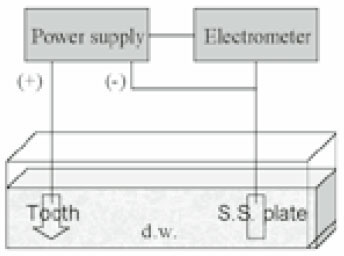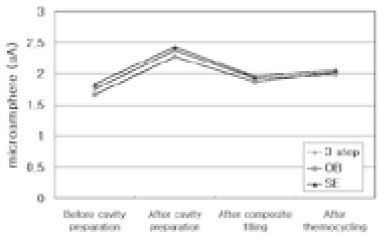J Korean Acad Conserv Dent.
2003 Mar;28(2):127-133. 10.5395/JKACD.2003.28.2.127.
Microleakage of various composite resin systems
- Affiliations
-
- 1Department of Conservative Dentistry, School of Dentistry, Dankook University, Korea. donyshin@dankook.ac.kr
- KMID: 1987240
- DOI: http://doi.org/10.5395/JKACD.2003.28.2.127
Abstract
- The object of this study was to compare the microleakage between various composite resin systems of multistep, one-bottle, and self-etching systems using electrical conductivity. After making class V cavities (4x3x1.5 mm around CEJ), they were bulk filled with three kinds of resins of A3. Teeth were storaged in a saline solution for one day, after then, they were finished and polished using Sof-Lex system. Another stress of thermocycling was made for 500 times from 5degrees to 55degrees C with each dwelling time of 10 seconds. Electrical conductivity (microamphere, microA) was checked four times: before and after cavity preparation, after filling, after thermocycling. One-way ANOVA and 95% Scheffe Post Hoc test was used for checking any statistical difference among groups. Another 95% Paired Samples T-test was also used for estimating any significant difference within group after cavity filling or thermocycling. The results were as follows: 1. Every specimen showed various range of microleakage after filling. There was, however, no difference between composite resin systems. 2. All composite resin systems showed marked increase in microleakage with a thermocycling (p<0.05), there was, however, no difference between composite resin systems. 3. Although there was no significant difference between groups (p=0.078), one-bottle and self-etching systems seemed to be unstable than multistep system. Within the limits of this study, it was concluded that much more consideration should be needed when using thermally unstable one-bottle and self-etching systems that have multi-advantages from simplified step. More studies will be needed to solve these kinds of problems.
Figure
Cited by 1 articles
-
Effect of a new resin monomer on the microleakage of composite resin restorations
JH Bae, YK Kim, PY Yoon, MA Lee, BH Cho
J Korean Acad Conserv Dent. 2007;32(5):469-475. doi: 10.5395/JKACD.2007.32.5.469.
Reference
-
1. Bowen RL. Adhesive bonding of various materials to hard tooth tissues. II. Bonding to dentin promoted by a surface-active comonomer. J Dent Res. 1965. 44(5):895–902.
Article2. Wieczkowski G, Joynt RB, Davis EL, Yu XY, Cleary K. Leakage patterns associated with glassionomer-based resin restorations. Oper Dent. 1992. 17(1):21–25.3. Rees JS, Jacobsen PH. The current status of composite materials and adhesive systems. 6: Techniques for indirect placement. Restorative Dent. 1991. 7(1):21–23.4. Dumsha T, Biron G. Inhibition of marginal leakage with a dentin bonding agent. J Dent Res. 1984. 63(10):1255–1257.
Article5. Going RE. Microleakage around dental restorations: a summarizing review. J Am Dent Assoc. 1972. 84:1349–1357.
Article6. Gordon M, Plasschaert AJM, Stark MM. Microleakage of several tooth-colored restorative materials in cervical cavities. a comparative study in vitro. Dent Mater. 1986. 2:228–231.
Article7. Douglas WH, Chen CJ, Craig RG. Neutron activation analysis of microleakage around a hydrophobic composite restorative. J Dent Res. 1980. 59(9):1507–1510.
Article8. Nelsen RJ, Woldott RB, Paffenbarger GC. Fluid exchange at the margins of dental restorations. J Am Dent Assoc. 1952. 44:288.
Article9. Martinez CR, Greener EH. Utilization of electrical conductivity as an alternative method of assessing marginal leakage of pit and fissure sealants. J Oral Rehabil. 1976. 3(1):69–74.
Article10. Marshall GW Jr. Dentin: Microstructure and characterization. Quintessence Int. 1993. 24:606–617.11. Buonocore MG. A simple method of increasing the adhesion of acrylic materials to enamel surfaces. J Dent Res. 1955. 34:849–853.
Article12. Croll TP, Helpin ML. Use of self-etching adhesive system and compomer for splinting traumatized incisors. Pediatr Dent. 2002. 24(1):53–56.13. Bouillaguet S, Gysi P, Wataha JC, Ciucchi B, Cattani M, Godin C, Meyer JM. Bond strength of composite to dentin using conventional, one-step, and self-etching adhesive systems. J Dent. 2001. 29(1):55–61.
Article14. Kemp-scholte CM, Davidson CL. Complete marginal seal of Class V resin composite restorations effected by increased flexibility. J Dent Res. 1990. 69:1240–1243.
Article15. Nakano Y. A new electrical testing method on marginal leakage of composite resin restorations. Jap J Conserv Dent. 1985. 28:1183–1198.16. Verdonschot EH, Rondel P, Huysmans MC. Validity of eletrical conductance measurements in evaluating the marginal integrity of sealant restorations. Caries Res. 1995. 29:100–106.
Article17. Santini A, Mitchell S. Microleakage of composite restorations bonded with three new dentin bonding agents. J Esthet Dent. 1998. 10(6):296–304.
Article18. Pilo R, Ben-Amar A. Comparison of microleakage for three one-bottle and three multiple-step dentin bonding agents. J Prosthet Dent. 1999. 82:209–213.
Article19. Iwami Y, Yamamoto H, Ebisu S. A new electrical method for detecting marginal leakage of in vitro resin restorations. J Dent. 2000. 28:241–247.
Article20. Besnault C, Attal JP. Influence of aa simulated oral environment on microleakage of two adhesive systems in Class II composite restorations. J Dent. 2002. 30:1–6.
Article21. Santini A, Plasschaert AJ, Mitchell S. Effect of composite resin placement techniques on the microleakage of two self-etching dentin-bonding agents. Am J Dent. 2001. 14(3):132–136.22. Cardoso PE, Placido E, Francci CE, Perdigão J. Microleakage of Class V resin-based composite restorations using five simplified adhesive systems. Am J Dent. 1999. 12:291–294.23. Reeves GW, Fitchie JG, Hembree JH, Puckett AD. Microleakage of new dentin bonding systems using human and bovine teeth. Oper Dent. 1995. 20(6):230–235.24. Manhart J, Chen HY, Mehl A, Weber K, Hickel R. Marginal quality and microleakage of adhesive class V restorations. J Dent. 2001. 29:123–130.
Article
- Full Text Links
- Actions
-
Cited
- CITED
-
- Close
- Share
- Similar articles
-
- Influence of flowable composite lining on microleakage at the gingival dentin margin
- Comparison of microleakage after load cycling for nanofilled composite resin fillings with or without flowable resin lining
- Microleakage and Shear Bond Strength of Biodentine at Different Setting Time
- Effect of biscover on the marginal microleakage of composite resin restoration
- Effect of resin sealants on the reduction of microleakage in composite restorations



